- Details
- Hits: 1224
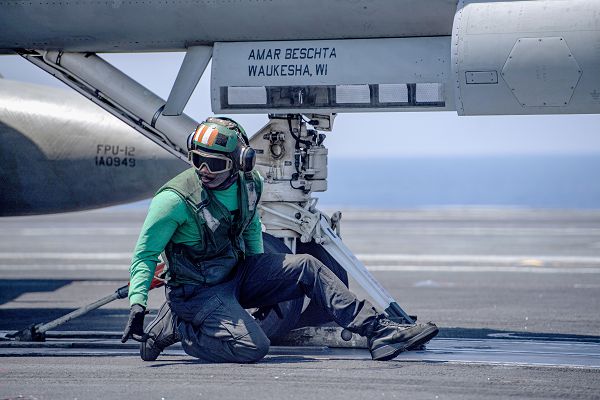
Philippine Sea. (May 16, 2023): The U.S. Navy recently announced the decision to retire the veritable USS Nimitz aircraft carrier just as the nation’s oldest-serving U.S aircraft carrier successfully completed its 350,000th arrested aircraft landing, a milestone nearly 48 years in the making. In this photo by MC2 Justin McTaggart, a Sailor prepares an F/A-18E Super Hornet from the “Kestrels” of Strike Fighter Squadron 137 for launch. Commissioned in 1975, the Nimitz has served with distinction in numerous regional crises around the world. Tens of thousands of Sailors and Marines have sailed on the Nimitz during some 30 deployments to fulfill difficult and dangerous missions.
The Navy named its largest and most powerful class of aircraft carrier in honor of the accomplishments of Chester W. Nimitz, Chief of Naval Operations during World War II.
Admiral Nimitz, who died in 1966 at age 80, not only commissioned America’s first nuclear powered submarine but also established the Navy’s elite Blue Angels flight demonstration squadron.
Plans for disassembling and salvaging the Nimitz are underway and, unless Congress extends its lifetime, this symbol of American firepower will no longer ply the world’s oceans defending freedom.
- Details
- Hits: 1090
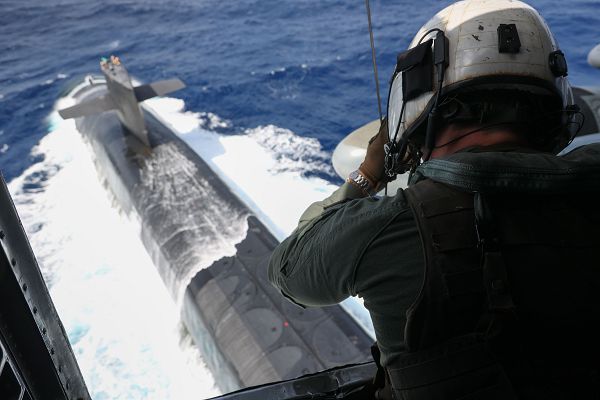
Philippine Sea. (May 17, 2023): In this photo by Lance Corporal Emily Weiss, Staff Sergeant Joseph McDonnell, a crew chief with Marine Heavy Helicopter Squadron 462, 1st Marine Aircraft Wing, III Marine Expeditionary Force, lowers a package to the Ohio-class ballistic missile submarine USS Maine during a vertical replenishment at sea. These airborne deliveries enable naval vessels to quickly take on vital supplies without interrupting maritime operations.
This at sea replenishment is a key factor in the Marine Corps “Stand In” concept of positioning its forces in wartime. The strategy is to devise ways to deploy and sustain forces as close to the enemy as possible. America currently has 14 Ohio Class nuclear submarines in service and another four converted into conventionally armed guided missile boats. These subs carry up to 154 Tomahawk cruise missiles and also serve as motherships for special forces.
Also known as “Boomers”, these submarines can be loaded with up to 20 Trident II ballistic missiles each with multiple independent warheads. The Navy's various classes of submarines can host of a variety of missions including stand-off strikes, intelligence-gathering, and discrete infiltration/extrication of special operations troops.
The ability to supply these vessels to resupply submarines while underway is critical to American combat success.
- Details
- Hits: 1332
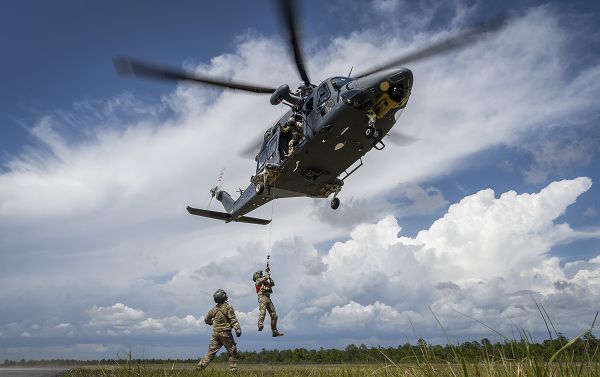
Eglin Air Force Base, Florida. (May 18, 2023): In this photo by Samuel King, Jr., an MH-139A Grey Wolf lifts an Air Force Global Strike Command Detachment 7 special mission aviator into the air as part of live hoist testing of the Air Force’s newest helicopter. The 413th Flight Test Squadron and Det. 7 worked together to successfully complete a series of critical performance tests on this latest in utility rotary wing aircraft.
The Grey Wolf replaces the venerable UH-1H Huey, our nation’s most rugged utility helicopter since the 1970s. The Grey Wolf flies 50% faster and has greater range than the Huey and can lift 5,000 lbs. more payload. Built by Boeing, the Grey Wolf can handle multiple roles ranging from protecting U.S. ballistic missile sites to transporting government officials and security forces. Today, its chief job is patrolling the US arsenal of land-based ICBMs and the bases that support these missile-laden silos.
To join the Air Force fleet, the Grey Wolf had to pass the rigorous testing program of two of the most unique units in the U.S. military; the 413th Flight Test Group and the Air Force Global Strike Command. One group is dedicated to sophisticated flight-testing methods and the other provides the pilots and special mission aviators.
The 413th, based at Robbins Air Force base, Georgia, is the Air Force’s only dedicated rotary test unit that conducts flight evaluations on aircraft being considered for acquisition. The group is a partnership between the Air Force Materiel and the Reserve Commands that supervise all flight test. The unit includes five squadrons made up of 140 full-time Airmen, 78 traditional reservists, and nine civil servants.
- Details
- Hits: 1230
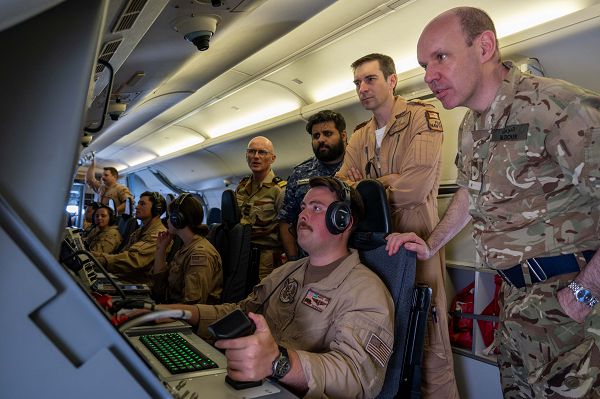
Strait of Hormuz. (May 14, 2023): In this photo by MC2 Jacob Vernier, naval personnel from Bahrain, France, United Kingdom, and United States conduct a multilateral patrol aboard a U.S. Navy P-8A Poseidon aircraft over the Strait of Hormuz. Tensions are rising in the region due to attacks on commercial shipping by the Islamic Republic of Iran. For a second time this week, the Islamic Revolutionary Guard Corps Navy seized another oil tanker in an escalation of attacks on privately owned ships operating legally in international waters. These illegal detentions threaten the freedom of navigation in this vital waterway, the choke point through which one fifth of the world’s oil flows.
The task of protecting free navigation through the Strait falls to the formidable U.S. Navy’s 5th Fleet, based in Bahrain. One of the key tools to monitor air and naval traffic in the Strait is the Boeing P-8A Poseidon. This is the latest maritime patrol and reconnaissance aircraft produced by Boeing Defense, Space & Security, for the United States Navy.
The Poseidon is a multi-mission aircraft used for maritime patrols to monitor vessels on and below the surface. Its design is based on the commercial Boeing 737-800 fuselage that has been substantially modified to include a weapons bay, increased electrical generation capacity, and strengthened wings for military operations.
The Poseidon has modern surveillance sensors, electronic counter measures, and a suite of radios, data links, and satellite communications gear. With a fuel capacity of almost 34 tons, the Poseidon can remain on station as far as 1,200 miles from base.
It is armed with torpedoes and Harpoon anti-ship missiles and can drop and monitor sonobuoys to detect enemy submarines. The Poseidon also deploys the Northrop Grumman MQ-4C Triton maritime surveillance unmanned aerial vehicle.
- Details
- Hits: 1142
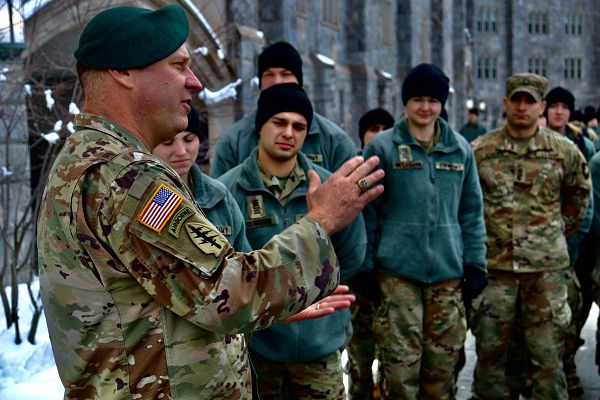
West Point, New York. (May 13, 2023): You can see it in their eyes, a sense of awe in knowing they are in the presence of a real live American hero. In this photo by Sergeant 1st Class Jared Gehmann, Medal of Honor recipient Master Sgt. Earl Plumlee speaks to cadets at the United States Army Military Academy at West Point, N.Y., just one of many stops in a continuous tour of Army posts around the world. MSgt. Plumlee spoke to these future officers about making tough decisions while in combat and the lessons he learned on leadership throughout his military career. Plumlee’s story is one of epic struggles to survive and one man’s determination to never give up the fight.
Plumlee received the military’s highest honor for actions against insurgents who attacked a U.S. outpost near Ghazni, Afghanistan, in August 2013. Plumlee, a weapons sergeant assigned to the 1st Special Forces Group (Airborne) was outnumbered and armed with only a pistol when he took on 10 heavily armed insurgents. In a series on daring maneuvers, Plumlee advanced on the enemy again and again braving heavy fire including several grenades.
- Details
- Hits: 1126

Grasmere, Idaho. (May 8, 2023): When one thinks “Air Force”, images of fighter jocks and crisp blue uniforms come immediately to mind. In the picture above by Lance Corporal Juan Torres, Marines from the 1st Marine Division locate their targets alongside Air Force Joint Terminal Attack Controllers at Saylor Creek Range at Grasmere, Idaho. Marines and Air Force personnel teamed up to test their skills in realistic combat conditions during Exercise Garnet Rattler held here recently.
A Joint Terminal Attack Controller JTACs (also called Forward Observers) directs the actions of attacking military aircraft engaged in close air support of Marine units on the ground and they do so often well behind enemy lines. Exercise Garnet Rattler centers around a comprehensive training program to enhance coordination between Air Force joint terminal attack controllers and other Marine Corps personnel involved in ground operations. The exercise involved 11 Marines undergoing advanced training as JTACs in simulated urban terrain using live ammunition and aided by close air support from neighboring units.
The training program included advanced technology, such as the Target Handoff System version 2.0, which allows JTACs to communicate with other units and provide critical information to the ground force commander. Saylor Creek is one of only a handful of firing ranges that can accommodate live fire exercises to hone close air support skills.


